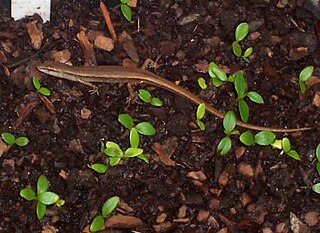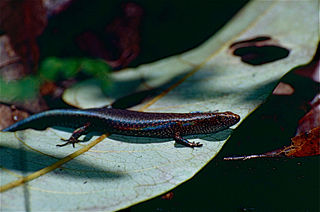
The macaques constitute a genus (Macaca) of gregarious Old World monkeys of the subfamily Cercopithecinae. The 23 species of macaques inhabit ranges throughout Asia, North Africa, and Europe. Macaques are principally frugivorous, although their diet also includes seeds, leaves, flowers, and tree bark. Some species such as the long-tailed macaque will supplement their diets with small amounts of meat from shellfish, insects, and small mammals. On average, a southern pig-tailed macaque in Malaysia eats about 70 large rats each year. All macaque social groups are arranged around dominant matriarchs.

Lampropholis is a genus of skinks, commonly known as sunskinks, in the lizard subfamily Eugongylinae of the family Scincidae. The genus Lampropholis was previously found to belong to a clade with the genera Niveoscincus, Leiolopisma and others of the Eugongylus group within Lygosominae. All species of Lampropholis are endemic to Australia. For similar skinks see genera Bassiana, Pseudemoia, and Niveoscincus.

Lampropholis delicata, the delicate skink, dark-flecked garden sun skink, garden skink, delicate garden skink, rainbow skink or plague skink, or the metallic skink is native to Australia and invasive in New Zealand and Hawaii where it is commonly found in gardens. The species is known for their color dimorphism between males and females; striped morphs and non-striped morphs exist in this species, however the stripe is less pronounced in males. This species' diet consists of a wide range of prey, such as spiders, bees, larvae, and termites. Mating occurs in the late summer and generally one clutch of 2 to 4 eggs are laid per year by each female.

Carinascincus metallicus, the metallic cool-skink or metallic skink is a species of skink in the family Scincidae. It is endemic to Australia, found in southern Victoria, as well as in Tasmania where it is the most widespread and common lizard, occurring on many offshore islands in Bass Strait as well as the mainland. It gives birth to live young. It is highly variable in colour and pattern, and may be a complex of closely related species.

Grundy Mountain or Mount Grundy, a mountain of the Great Dividing Range, is located on the Northern Tablelands of New South Wales, Australia.
Eupithecia amicula is a moth in the family Geometridae first described by Vladimir G. Mironov and Anthony Charles Galsworthy in 2005. It is found in south-western and western Chinese provinces of Sichuan, Yunnan and Shaanxi.
The Burdekin Gap, named for the Burdekin River, is a biogeographical feature in Queensland, northeastern Australia, which separates populations of freshwater fishes and other water-dependent land animals, such as the delicate skink by a corridor of hot and dry habitat that acts as a barrier to genetic exchange. Birds, except those that are rainforest-dependent, are more likely to intergrade across the Gap.
Patrick J. Couper is a herpetologist in Queensland, Australia. Born in New Zealand, he migrated to Australia in 1981. Couper began his career at the Queensland Museum in 1984. He was initially employed in display construction, and became a research assistant in herpetology in 1986 under the direction and mentorship of the admired senior curator and head of Vertebrate Zoology, Jeanette Covacevich. Since 1993 he has been Curator of Reptiles and Amphibians at the Queensland Museum. A major research focus has been leaf-tailed geckos that inhabit rainforest and rock habitats in eastern Queensland and New South Wales.
Lampropholis adonis, also known commonly as the diamond shielded sunskink and Ingram's litter skink, is a species of skink, a lizard in the family Scincidae. The species is endemic to Queensland in Australia.
Lampropholis bellendenkerensis is a species of skink, a lizard in the family Scincidae. The species is endemic to Australia.
Lampropholis caligula, also known commonly as the montane sunskink or the montane sun skink, is a species of lizard in the family Scincidae. The species is endemic to New South Wales in Australia.

Lampropholis coggeri, also known commonly as the northern sun skink and the rainforest sunskink, is a species of lizard in the family Scincidae. The species is endemic to Queensland in Australia.
Lampropholis colossus, the Bunya sunskink, is a species of skink, a lizard in the family Scincidae. The species is endemic to Queensland in Australia.

Lampropholis couperi, commonly known as the plain-backed sunskink, is a species of skink, a lizard in the family Scincidae. The species is endemic to Queensland, Australia.
Lampropholis elongata, the long sunskink or elongate sunskink, is a species of skink, a lizard in the family Scincidae. The species is endemic to eastern Australia.
Lampropholis mirabilis, the saxicoline sunskink, is a species of skink, a lizard in the family Scincidae. The species is endemic to Queensland in Australia.
Lampropholis robertsi, the grey-bellied sunskink, is a species of skink, a lizard in the family Scincidae. The species is endemic to Queensland in Australia.

Saproscincus challengeri, also known commonly as the Border Ranges shadeskink, Challenger's skink, the challenging shade skink, and the orange-tailed shadeskink, is a species of lizard in the family Scincidae. The species is native to New South Wales and Queensland in Australia.

Saproscincus czechurai, also known commonly as Czechura's litter-skink, Czechura's skink, and the wedge-snouted shadeskink, is a species of lizard in the family Scincidae. The species is endemic to Queensland in Australia.

Scincella cherriei, commonly known as the brown forest skink and Cope's brown forest skink, is a species of lizard in the family Scincidae. The species is native to Central America and adjacent southeastern Mexico. Three subspecies are recognized.











